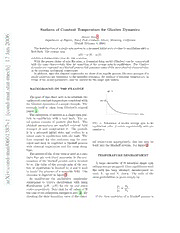Table Of ContentSurfaces of Constant Temperature for Glauber Dynamics
6
David Ford∗
0
0 Department of Physics, Naval Post Graduate School, Monterey, California
2 (Dated: February 6, 2008)
n Thewavefunction ofasingle spinsystemin apreparedinitial stateevolvestoequilibriumwith a
a heat bath. The average spin
J q(t)=p↑(t)−p↓(t)
7 exhibitsa characteristic time for thisevolution.
1 With the proper choice of spin flip rates, a dynamical Ising model (Glauber) can be constructed
with the same characteristic time for transition of the average spin to equilibrium. The Glauber
]
dynamicsareexpressedasaMarkoffprocessthatpossessesmanyofthesamephysicalcharacteristics
h
c as its quantummechanical counterpart.
e Inaddition,sincetheclassical trajectories arethoseofan ergodicprocess(thetimeaveragesofa
m single trajectory are equivalent to the ensemble averages), the surfaces of constant temperature, in
terms of themodel parameters, may bederived for thesingle spin system.
-
t
a
t
s BACKGROUND ON THE EXAMPLE
.
t
a
m The goal of this short note is to establish the
surfacesofconstanttemperatureconsistentwith
-
d theGlauberdynamicsofasimpleexample. The
n
example itself is taken from Glauber’s original
o
paper [1].
c
[ Thesubsystemofinterestisasinglespinpar-
ticle in equilibrium with a heat bath. The to-
1
tal system consists of particle plus bath. The
v FIG. 1: Relaxation of known average spin to its
7 physical parameters are applied external field equilibrium value β occurs exponentially with pa-
8 strength H and temperature θ. The particle rameter α.
3 is in a prepared initial state and evolves to a
1
mixed state in equilibrium with the bath. The
0
time constant for this evolution may be mea-
6
cal trajectories appropriately, this too may be
0 sured and used to construct a Markoff process
built into the Markoff process. See figure 2.
/ with classical trajectories and the same decay
t
a time.
m
Theinverseofthedecaytimeisusedasarate
TEMPERATURE DEVELOPMENT
- (spin flips per unit time) parameter in the con-
d
struction of the Markoff process and is denoted
n
A large ensemble of N identical single spin
o by α. The value of the average spin of the sys-
subsystemsareprepared. Onceequilibriumwith
c tem at equilibrium is denoted by β and is used
: the bath has been attained, measurement re-
v to model the presence of a magnetic field. This
veals N up and N down. The ratio of the
i situation is depicted in figure 1. ↑ ↓
X state probabilities is given simply by
At equilibrium the probability amplitudes
r
a correspond to Gibb’s distribution with Ising
Hamiltonian (µH,−µH) for the up and down p N
↑ ↑
= .
states respectively. Note that forall values ofH p N
↓ ↓
thesumofthesubsystemenergiesiszero[2]. By
choosing the state transition rates of the classi- If the time evolution of a Markoff process is
2
Clearly, since the two languages describe the
same phenomenon, there is an implied mapping
between the θ−axis in (H,θ)−space and the
α−axis in the (α,β)−space. In systems whose
parameterization lies purely along either the α
orθ−axes,theamountoftimespentspinupper
characteristic period is equal to the amount of
timespentspindown. Thisimpliesanotherpair
of mappings between these axes and the line
∆t =∆t
↑ ↓
FIG.2: CharacteristicholdingtimesandtotalCarl-
son depth for thestates of the single spin system in the time domain.
Note that for arbitrary constants λ and λ ,
1 2
the transitions (dilatations)
ergodic, the state probabilities may also be ex-
pressed in terms of the epochs of the average
(∆t ,∆t )−→(λ ∆t ,λ ∆t )
↑ ↓ 1 ↑ 1 ↓
cycle behavior. See figure 2. Per characteristic
cycle time, the associated equilibrium Markoff
and
process (as defined by the state transition rates
for the spins) spends
(H,θ)−→(λ H,λ θ)
2 2
2
∆t =
↑ α(1−β) leave the probabilities invariant. The direction
ofmaximumprobabilitygradientliesperpendic-
ulartotheseinvariantdirectionsineitherspace.
2
See figure 3.
∆t =
↓
α(1+β)
in the up and down states respectively. The
probability ratios are given by
2
p↑ α(1−β) 1+β
= = .
p 2 1−β
↓ α(1+β)
At zero field, neither state ↑ or ↓ is preferred. FIG. 3: Observers agree on lines (constant proba-
bilities) and circular arcs (maximum ∇p) in both
The classical single particle system switches
spaces.
from one state to the other at random. In the
language of the Glauber parameters this situa-
tion corresponds to
In [2], these simple observations are used
to construct the surfaces of constant tempera-
α6=0, β =0. ture in time. That is, the image of the lines
θ = constant, in the (H,θ)−space, mapped to
Alternatively, in terms of the system temper-
(∆t ,∆t )−space via the relation
↑ ↓
ature and applied field
const.
θ(∆t)= .
θ 6=0, H =0. k∆tk2q(log[∆∆tt↑↓])2+1
3
ture,thedecayparameterαfortheaveragespin
q(t)−β increases with increasing applied field
parameter β.
BIBLIOGRAPHY
FIG.4: Linesof constant temperatureas seenfrom
the time domain coordinates (∆t↑, ∆t↓) and in
terms of the Markoff parameters (α, β).
∗ [email protected]
[1] R. Glauber, “ Time DependentStatistics of the
These surfaces are presented in the left hand
IsingModel”, J.Math.Physics4,2,pp.294-307,
paneloffigure4. Therighthandpanelofthefig- 1963
ureshowsthesamesurfacesasseenfrom(α,β)- [2] D. Ford, “Surfaces of Constant Tempera-
space. tureinTime,” http://www.arxiv.org/abs/cond-
The implication is that, at constanttempera- mat/0510291, 2005

